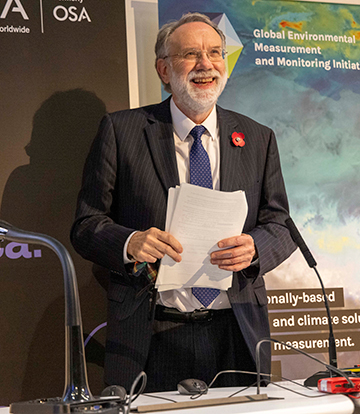
Optica Fellow Allister Ferguson, University of Strathclyde, acted as general host for the GEMM event. [Image: Stuart Forsyth/GEMM]
In the past two weeks, the world’s attention has focused on the efforts—and the sometimes disappointing outcomes—of the United Nations COP26 climate conference in Glasgow, Scotland, UK. On Wednesday, 3 November, a parallel, smaller Glasgow-based event shone a spotlight on a particularly relevant concern for COP26: the role of cities in the climate crisis—and how helping them better track local air quality could offer a potent tool in the battle against global carbon emissions.
The daylong scientific/policy conference, dubbed “Cities Are the Key to the Climate Solution,” was a hybrid in-person/virtual event held at the University of Strathclyde Technology and Innovation Center. It was convened by the Global Environmental Measurement and Monitoring (GEMM) Initiative, a worldwide project jointly run by Optica (formerly OSA) and the American Geophysical Union (AGU).
The GEMM project itself centers on an effort to deploy dense networks of inexpensive, photonically enabled air-quality sensors in cities. The aim is provide municipal and regional leaders with real-time, actionable information on ambient levels of greenhouse gases (GHGs), air pollutants and particulate matter that can immediately inform their climate and air-quality efforts. The Glasgow setting for both COP26 and the “Cities” conference was appropriate, as one of GEMM’s first demonstration projects involves an effort to install some 25 of the environmental sensors in Glasgow itself.
The 70% solution
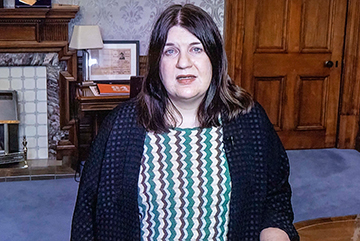
City of Glasgow Council leader Susan Aitken, participating by videoconference, stressed that climate change and urban pollution constitute “a clear social-justice issue” for municipalities. [Image: Stuart Forsyth/GEMM]
As several of the “Cities” conference participants noted in their remarks, the word “Glasgow” is sometimes loosely translated from Gaelic as “Dear Green Place.” Yet the speakers also noted that Glasgow—an epicenter of the 18th- and 19th-century Industrial Revolution in Great Britain (and, during the late 1800s, one of the world’s largest and fastest-growing cities)—historically has had a complex and sometimes fraught relationship with its environment. Even today, according to Susan Aitken, the leader of the City of Glasgow Council, who addressed the meeting by videoconference, transportation emissions and air quality remain “a clear social-justice issue,” and one that disproportionately impacts “our most disadvantaged communities.”
Yet in a larger sense, cities such as Glasgow and many others also weigh heavily in the global climate emergency. One sobering metric, frequently cited in the course of the “Cities” summit, is that the world’s cities collectively are responsible for more than 70% of global GHG emissions.
“Our context is not unique; it’s shared hundreds of times over by our peers globally,” Aitken said. “Cities like ours may be where the greatest challenges to decarbonization lie, but they’re also where the greatest gains are to be found.” Or, in the words of Sir Jim McDonald, the principal and vice chancellor of the University of Strathclyde: in practically addressing climate change, “there’s no better place to start” than the cities.
Toward real-time data
Beyond the outsized role that cities play in any climate solution, another key theme of the meeting was the importance of good local emissions data—delivered in real time.
Alistair Manning, from the UK’s Met Office, described the government’s impressive effort to collect statistics on GHG emissions, and how those efforts have documented the country’s successes and challenges in reducing emissions on a national level. But, he pointedly observed, the data from the UK’s broad national inventory is “always two years behind. So that’s the problem.” That, he suggested, stands in the way of allowing cities to assess the success of their own emission-control programs on a day-by-day basis, and to make necessary adjustments.
Janene Tuniz of the United Nations Human Settlement Programme sounded a similar note, alluding to a persistent “data gap” in addressing climate-relevant issues in economically under-resourced areas.
![]()
Urban skyline of the city of Glasgow, Scotland, the host city for the UN COP26 conference. [Image: S. Kroes/Getty Images]
Fewer than half of the 193 countries participating in the UN’s sustainable-development goals, Tuniz said, have “internationally comparable data.” She added that some of her program’s work in sub-Saharan Africa—where old, poorly maintained vehicle fleets constitute a huge air-quality and GHG emission problem—has revealed that “data generated by low-cost sensors in cities where there are no formal measuring stations can greatly enhance insights and knowledge” to connect the dots for better policy.
Multidisciplinary approach
Getting to such dense, low-cost urban sensor networks, of course, is the raison d’être of the GEMM program. Optica Fellow and OSA 2009 President Thomas Baer, a key figure behind the GEMM Initiative, described the effort in remarks delivered by videoconference. He noted that the program is building multidisciplinary centers bringing together scientists, engineers, policy makers, economists and other experts to develop and deploy “new measurement technologies and improved climate models.”
In projects both in northern California in the United States and Glasgow in Scotland, the initiative has focused on implementing dense spatial arrays of low-cost, photonically enabled GHG and pollution monitoring equipment. Such networks, Baer said, offer data that can “provide input into models that allow predictions of the impact of government policies and GHG emission levels,” and of their practical and economic effects.
Another key figure in the project, Ronald Cohen of the University of California, Berkeley—whose team pioneered the engineering of the low-cost sensors being used in the project—described the experience deploying the sensors both in the California and Glasgow projects. “We are trying to develop a strategy for driving the price of measurements down to the point where the sensors themselves are no longer dominating the cost—it’s the labor cost of interpreting the observations that drive the cost of the project. And we’ve gotten to that point.”
The importance of stories
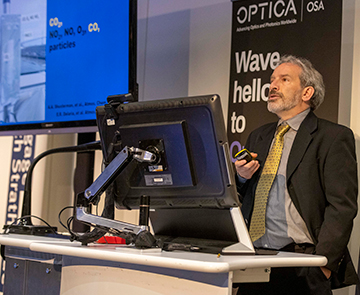
Ronald Cohen, UC Berkeley, a pioneer in low-cost urban sensors, at the GEMM event. [Image: Stuart Forsyth/GEMM]
Cohen shared concrete examples of how analysis of the sensor data, particularly in the California installation, have illuminated some unexpected and valuable areas, such as assessments of changes in the fuel efficiency of the average vehicle on the road, and the emissions impact of shelter-in-place orders during the COVID-19 emergency. “You know, observations are only one part of what we’re trying to do,” Cohen said. “The other part is to tell stories that help people who are managing cities think about whether or not their objectives are being met.”
One dimension to such storytelling—as suggested by Karina Cucchi, the chief solutions officer of the Paris-based start-up Origins.earth (which recently joined the GEMM project)—is providing practical entry points and tools for city officials actually to use the data. Cucchi demonstrated the company’s online tool, Météo Carbone, which packages a wealth of disparate CO2 emissions data into maps and other visualizations that can help assess and fine-tune local climate actions.
In summing up the value of such tools, Cucchi drew an analogy with smartphones. “These are technology marvels, [but] you don’t need to understand microprocessors and cloud computing to operate them,” she said. “And that’s our vision with climate data—we want to make it accessible not only to the specialists, but also to city stakeholders and citizens.”
Multivariable problem
The remarks by Cohen and Cucchi underscored yet another theme of the “Cities” summit: that however important cities are to addressing global climate change, their actions inevitably take place in specific local and regional contexts, involving local and regional priorities, politics and economics.
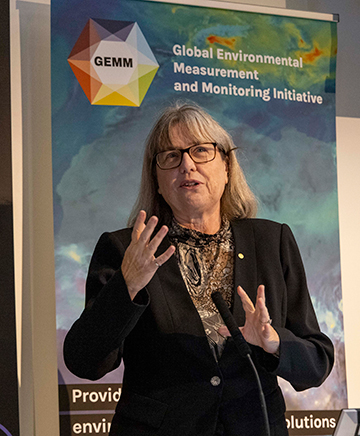
Nobel laureate and Optica Fellow Donna Strickland at the GEMM event. [Image: Stuart Forsyth/GEMM]
Optica Fellow, 2013 OSA President and Nobel laureate Donna Strickland, for example, talked about her own efforts to build a GEMM program in her home country of Canada. That effort, she said, has involved building partnerships with the country’s National Research Council and also with Quebec’s Université Laval.
The latter, Strickland noted, has developed strong programs in both photonics and environmental sensing—especially for the sensitive arctic regions that constitute such a large part of Canada’s land mass, and that are a bellwether of climate change’s broader impacts. Strickland also underscored the importance of engaging with the country’s indigenous populations and “including indigenous voices” in this pan-Canadian initiative.
Thinking locally
Other participants throughout the day also stressed the importance of continually keeping an eye on this local perspective. “Local solutions are the building blocks of everything,” said Randy Fiser, the CEO of AGU. A “co-creation model” that involves and engages the local community, he added, is what “begins to engender trust in the science.”
Carol Monaghan, a member of the UK Parliament for Glasgow North West, also focused on the need to make sure that “the evidence you’re gathering is heard by the right people or read by the right people.” And, in remarks in a panel discussion toward the end of the “Cities” conference, she emphatically included the local public among those stakeholders.
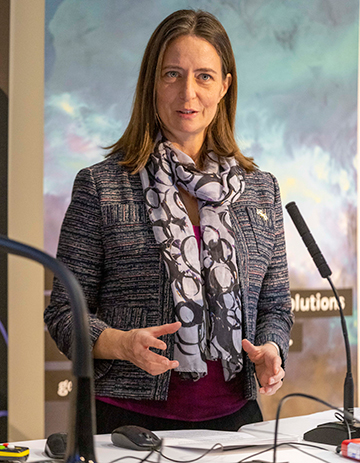
Carol Monaghan, a UK Parliament member, emphasized the need to involve local communities in climate measures. [Image: Stuart Forsyth/GEMM]
“Here in Glasgow, we hear about climate change, and we hear about glaciers melting or droughts in Africa, but it doesn’t feel as though it really has an impact,” Monaghan observed. But, she added, things become different when “we start seeing things happening locally.” That makes it crucial, she said, to speak to the public directly and get their buy-in.
Monaghan expressed the hope that the GEMM experience in Glasgow could serve as a model for other municipalities on how “a city can use new models to make critical decisions.” GEMM leader Thomas Baer echoed the thought at the close of the summit.
The GEMM projects in Glasgow and California are “demonstrating how city officials, working with universities, can put in place emission reduction policies that are effective, practical and equitable,” Baer said. And that, he added, has potential wins both for global climate and for local quality of life. “We welcome the opportunity to coordinate similar programs for interested cities across the globe.”
The role of cities in addressing climate change will also be the focus of a COP26 UK “Presidency Program” that will be livestreamed on Thursday, 11 November.
